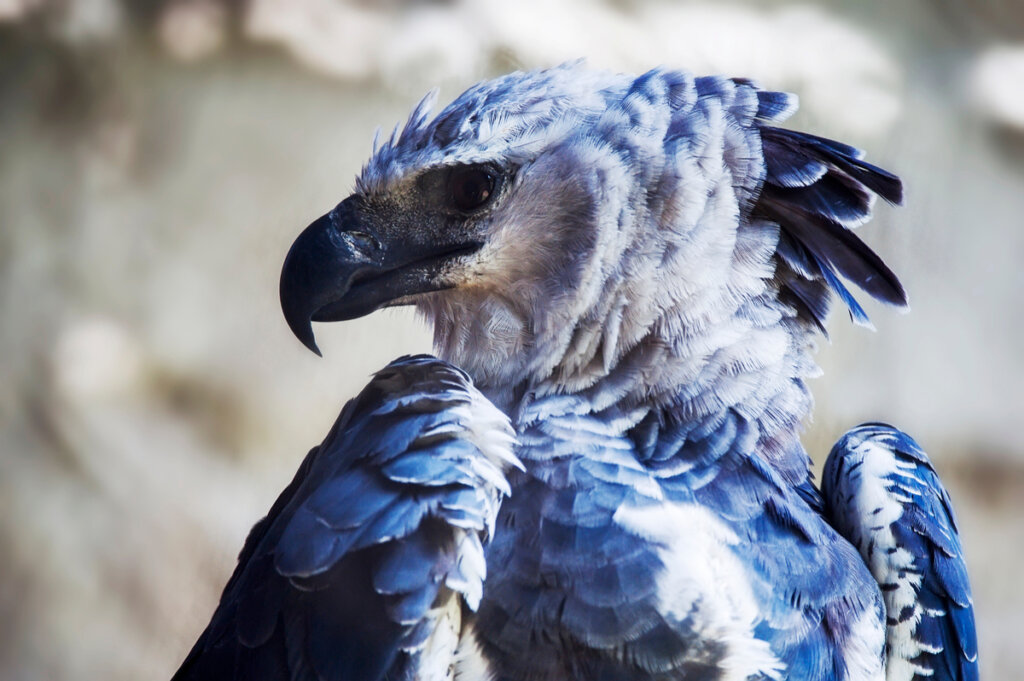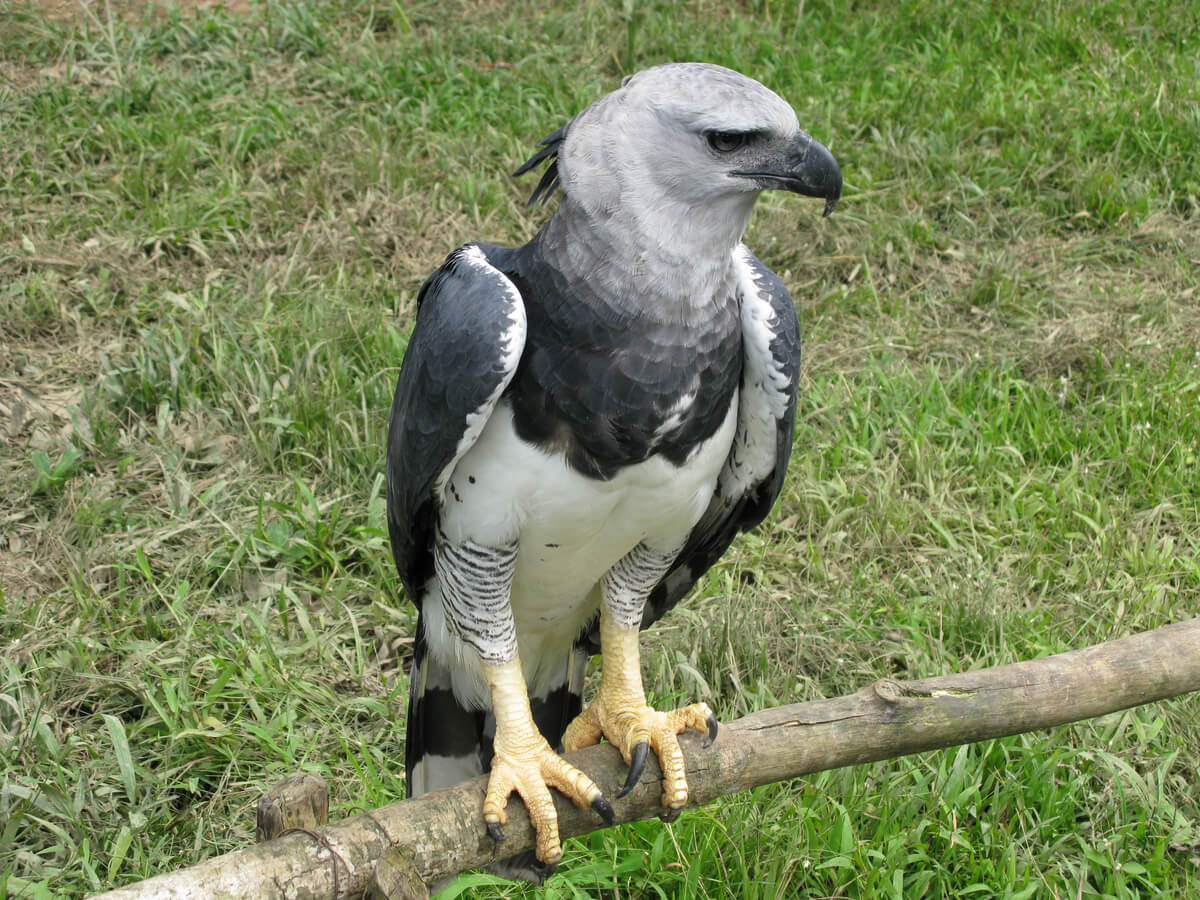Harpy Eagles Endangered Due to Deforestation in the Amazon

The “lungs of the world”, the Amazon, is in danger and its inhabitants are disappearing little by little. An increasingly notorious case is that of harpy eagles, which are approaching extinction due to deforestation in the Amazon. For them, both nesting and feeding are becoming an impossible task.
A group of scientists has monitored these raptors to determine the exact point they’re at in terms of their conservation. The main threats they face are also being analyzed in order to implement solutions. If you want to know a little more about these incredible birds and their situation, keep reading.
Characteristics of the harpy eagle
The harpy eagle (Harpia harpyja) is a diurnal raptor of the Accipitridae family. It’s the largest eagle in the world, up to one meter long (3.3 feet) and 2 meters (6.6 feet) wide. Their claws can be up to 12.5 centimeters (5 inches) long. Females are normally larger, with an average weight of 7 to 9 kilograms (15 to 20 pounds), while males weigh an average of 5 to 8 kilograms.
The crown of feathers that these birds have on their heads are raised when threatened, although some theorize that they also raise them to direct the sound to their ears.
These raptors are most often found in monogamous pairs that mate for life. A third member is also sometimes seen, which is their offspring from the most recent breeding season.
The main food sources for harpy eagles are sloths and primates, but they’ve also been known to feed on lizards, birds, rodents, and sometimes small deer. Their ability to maneuver in the air is amazing, as they move perfectly between the density of the branches of the thick Amazon forest.

Harpy eagles, endangered by deforestation in the Amazon
Like all animal species that inhabit the Amazon, harpy eagles suffer the consequences of human action, in this case, the brutal deforestation of their area. In 2020, the Brazilian Amazon lost 11,088 square kilometers of trees (about 6900 miles), 9.5% more than the previous year.
For this reason, a group of scientists carried out a study to determine which aspects of the life of the harpy eagle were the most affected by deforestation. During the investigation, 16 active nests of this species were monitored, all located in Amazonian landscapes of Mato Grosso (Brazil) that had suffered between 0 and 85% loss of forest.
Study results
Harpy eagles need quality environments in order to raise their chicks, so extinction is a fairly clear possibility when faced with deforestation in the Amazon. In addition, their prey (primates and sloths) are of considerable size, so they’re scarce in very deteriorated areas.
Landscapes deforested by more than 70% aren’t suitable for building nests. On the other hand, the parents can’t help their offspring towards independence in areas with a loss of forest greater than 50%, the study indicates. Harpy eagles were also found to be unable to vary their diet in places where capuchin monkeys and sloths were scarce.
“During the study we saw chicks that only received food every 15 days before dying,” said Everton Miranda, lead author of the research.
Feeding rates decreased with the loss of forest. In areas with 50-70% deforestation, 3 animals died of starvation. In this way, the team of researchers estimated that around 35% of northern Mato Grosso was not suitable for breeding. This situation may have caused a decrease of 3,256 breeding pairs since 1985.
Other threats to harpy eagles
Anthropogenic habitat degradation and a shortage of prey due to poaching force predators to adapt and feed on alternative species. However, the harpy eagle hasn’t been able to find other prey in deforested areas.
On the other hand, the maturation period of this bird of prey is the longest of its kind: the parents take care of the young until they reach 10 months of age. Once they become independent, the juveniles remain in the feeding area of the parents for another year. If this whole process occurs in a deforested area, the chances of survival are almost nil.
The harpy eagle lives from central Mexico to northern Argentina. However, despite being protected by law in several countries, this bird is hunted illegally throughout the Amazon. As you can imagine, this further complicates their already delicate conservation situation.
The population of this raptor is falling rapidly, as the hectares of the Amazon disappear from one day to the next, literally. To this day it has been given Near Threatened (NT) status by the International Union for Conservation of Nature (IUCN). Its population is in decline and it won’t stop until governments and companies commit to preventing the destruction of the most valuable forest on planet Earth.
All cited sources were thoroughly reviewed by our team to ensure their quality, reliability, currency, and validity. The bibliography of this article was considered reliable and of academic or scientific accuracy.
- BirdLife International. 2017. Harpia harpyja (amended version of 2017 assessment). The IUCN Red List of Threatened Species 2017: e.T22695998A117357127. https://dx.doi.org/10.2305/IUCN.UK.2017-3.RLTS.T22695998A117357127.en. Downloaded on 09 September 2021.
- Harpia harpyja (harpy eagle). (s. f.). Animal Diversity Web. Recuperado 9 de septiembre de 2021, de https://animaldiversity.org/accounts/Harpia_harpyja/
- Miranda, E. B., Peres, C. A., Carvalho-Rocha, V., Miguel, B. V., Lormand, N., Huizinga, N., … & Downs, C. T. (2021). Tropical deforestation induces thresholds of reproductive viability and habitat suitability in Earth’s largest eagles. Scientific reports, 11(1), 1-17.